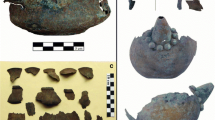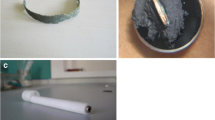Abstract
In the framework of the EFESTUS project (funded by the European Commission, contract No. ICA3-CT-2002-10030) the corrosion products of a large number of archaeological bronze artefacts are investigated by means of the combined use of scanning electron microscopy (SEM), energy dispersive spectrometry (EDS), X-ray diffraction (XRD) and optical microscopy (OM) and tentative correlation of their nature with the chemical composition of the artefacts and the burial context is proposed.
The results provide good insight into the corrosion layers and evidence in some bronze Roman coins and artefacts; the occurrence of uncommon corrosion phenomena that give rise to the formation of a yellowish-green complex chlorine-phosphate of lead (pyromorphite, (PbCl)Pb4(PO4)3) and of a gold-like thick layer of an iron and copper sulphide (chalcopyrite, CuFeS2). The micro-chemical and micro-structural results show that the coins were buried in a soil enriched in phosphorus for the accidental presence of a large amount of decomposing fragments of bones or in an anaerobic and humus rich soil where the chalcopyrite layer has been produced via the interaction between the iron of the soil, the copper of the coin and the sulphur produced by the decomposition of organic matter in an almost oxygen free environment. Finally, some unusual periodic corrosion phenomena occurring in high tin bronze mirrors found at Zama (Tunisia) are described.
Similar content being viewed by others
References
D.A. Scott, J. Am. Inst. Conservation 29, 193 (1990)
F. Schweitzer, Symposium organised by the Paul Getty Museum Proc., ed. by D.A. Scott, J. Podany, B.B. Considine (Paul Getty Museum, Malibou, California, USA, 1994) p. 1–20
D.A. Scott, Copper and Bronze in Art, Corrosion, Colorants, Conservation (Paul Getty Conservation Institute, Malibou California, USA, 2002) p. 224
W.A. Oddy, N.D. Meeks, Proceedings of the Conference Science and Technology in the Service of Conservation (Washington, 3–9 September 1982) p. 119
G.M. Ingo, E. Angelini, T. de Caro, G. Bultrini, I. Calliari, Appl. Phys. A 79, 199 (2004)
E. Angelini, P. Bianco, F. Zucchi, Proceedings of Progress in the Understanding and Prevention of Corrosion, Vol. 1, (Barcelona, Spain, July 1993) p. 14
G.M. Ingo, E. Acquaro, L.I. Manfredi, G. Bultrini, G. Chiozzini, C. Veroli, Materials Issues in Art and Archaeology V, Vol. 462 Materials Research Society (1998) p. 411
C.G. Fink, The Corrosion Handbook, ed. by H.H. Uhlig, (Wiley, New York, 1948) p. 103
D.A. Scott, Stud. Conserv. 30, 49 (1985)
G.M. Ingo, E. Angelini, T. de Caro, G. Bultrini, A. Mezzi, Surf. Interf. Anal. 36, 871 (2004)
Author information
Authors and Affiliations
Corresponding author
Additional information
PACS
68.55Jk; 68.35 Dv; 68.37Hk; 68.55 Nq; 81.05 Bx
Rights and permissions
About this article
Cite this article
Ingo, G., de Caro, T., Riccucci, C. et al. Uncommon corrosion phenomena of archaeological bronze alloys. Appl. Phys. A 83, 581–588 (2006). https://doi.org/10.1007/s00339-006-3534-z
Received:
Accepted:
Published:
Issue Date:
DOI: https://doi.org/10.1007/s00339-006-3534-z




